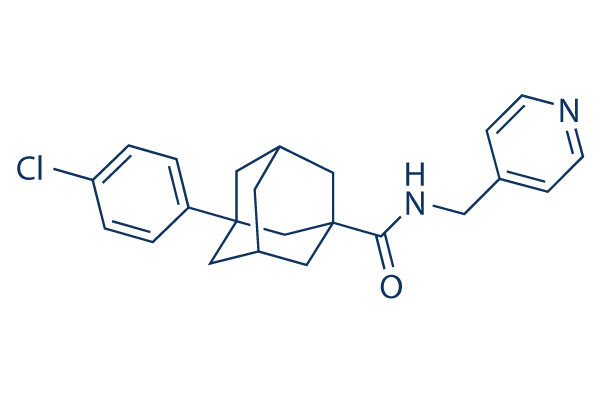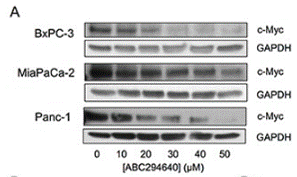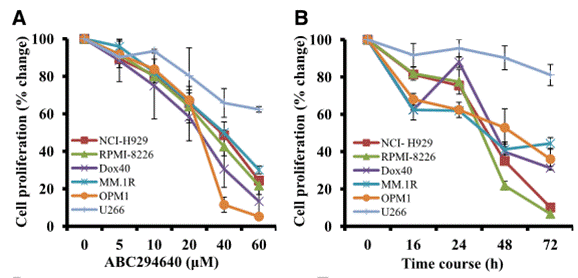
- Bioactive Compounds
- By Signaling Pathways
- PI3K/Akt/mTOR
- Epigenetics
- Methylation
- Immunology & Inflammation
- Protein Tyrosine Kinase
- Angiogenesis
- Apoptosis
- Autophagy
- ER stress & UPR
- JAK/STAT
- MAPK
- Cytoskeletal Signaling
- Cell Cycle
- TGF-beta/Smad
- DNA Damage/DNA Repair
- Compound Libraries
- Popular Compound Libraries
- Customize Library
- Clinical and FDA-approved Related
- Bioactive Compound Libraries
- Inhibitor Related
- Natural Product Related
- Metabolism Related
- Cell Death Related
- By Signaling Pathway
- By Disease
- Anti-infection and Antiviral Related
- Neuronal and Immunology Related
- Fragment and Covalent Related
- FDA-approved Drug Library
- FDA-approved & Passed Phase I Drug Library
- Preclinical/Clinical Compound Library
- Bioactive Compound Library-I
- Bioactive Compound Library-Ⅱ
- Kinase Inhibitor Library
- Express-Pick Library
- Natural Product Library
- Human Endogenous Metabolite Compound Library
- Alkaloid Compound LibraryNew
- Angiogenesis Related compound Library
- Anti-Aging Compound Library
- Anti-alzheimer Disease Compound Library
- Antibiotics compound Library
- Anti-cancer Compound Library
- Anti-cancer Compound Library-Ⅱ
- Anti-cancer Metabolism Compound Library
- Anti-Cardiovascular Disease Compound Library
- Anti-diabetic Compound Library
- Anti-infection Compound Library
- Antioxidant Compound Library
- Anti-parasitic Compound Library
- Antiviral Compound Library
- Apoptosis Compound Library
- Autophagy Compound Library
- Calcium Channel Blocker LibraryNew
- Cambridge Cancer Compound Library
- Carbohydrate Metabolism Compound LibraryNew
- Cell Cycle compound library
- CNS-Penetrant Compound Library
- Covalent Inhibitor Library
- Cytokine Inhibitor LibraryNew
- Cytoskeletal Signaling Pathway Compound Library
- DNA Damage/DNA Repair compound Library
- Drug-like Compound Library
- Endoplasmic Reticulum Stress Compound Library
- Epigenetics Compound Library
- Exosome Secretion Related Compound LibraryNew
- FDA-approved Anticancer Drug LibraryNew
- Ferroptosis Compound Library
- Flavonoid Compound Library
- Fragment Library
- Glutamine Metabolism Compound Library
- Glycolysis Compound Library
- GPCR Compound Library
- Gut Microbial Metabolite Library
- HIF-1 Signaling Pathway Compound Library
- Highly Selective Inhibitor Library
- Histone modification compound library
- HTS Library for Drug Discovery
- Human Hormone Related Compound LibraryNew
- Human Transcription Factor Compound LibraryNew
- Immunology/Inflammation Compound Library
- Inhibitor Library
- Ion Channel Ligand Library
- JAK/STAT compound library
- Lipid Metabolism Compound LibraryNew
- Macrocyclic Compound Library
- MAPK Inhibitor Library
- Medicine Food Homology Compound Library
- Metabolism Compound Library
- Methylation Compound Library
- Mouse Metabolite Compound LibraryNew
- Natural Organic Compound Library
- Neuronal Signaling Compound Library
- NF-κB Signaling Compound Library
- Nucleoside Analogue Library
- Obesity Compound Library
- Oxidative Stress Compound LibraryNew
- Plant Extract Library
- Phenotypic Screening Library
- PI3K/Akt Inhibitor Library
- Protease Inhibitor Library
- Protein-protein Interaction Inhibitor Library
- Pyroptosis Compound Library
- Small Molecule Immuno-Oncology Compound Library
- Mitochondria-Targeted Compound LibraryNew
- Stem Cell Differentiation Compound LibraryNew
- Stem Cell Signaling Compound Library
- Natural Phenol Compound LibraryNew
- Natural Terpenoid Compound LibraryNew
- TGF-beta/Smad compound library
- Traditional Chinese Medicine Library
- Tyrosine Kinase Inhibitor Library
- Ubiquitination Compound Library
-
Cherry Picking
You can personalize your library with chemicals from within Selleck's inventory. Build the right library for your research endeavors by choosing from compounds in all of our available libraries.
Please contact us at info@selleckchem.com to customize your library.
You could select:
- Antibodies
- Bioreagents
- qPCR
- 2x SYBR Green qPCR Master Mix
- 2x SYBR Green qPCR Master Mix(Low ROX)
- 2x SYBR Green qPCR Master Mix(High ROX)
- Protein Assay
- Protein A/G Magnetic Beads for IP
- Anti-Flag magnetic beads
- Anti-Flag Affinity Gel
- Anti-Myc magnetic beads
- Anti-HA magnetic beads
- Poly DYKDDDDK Tag Peptide lyophilized powder
- Protease Inhibitor Cocktail
- Protease Inhibitor Cocktail (EDTA-Free, 100X in DMSO)
- Phosphatase Inhibitor Cocktail (2 Tubes, 100X)
- Cell Biology
- Cell Counting Kit-8 (CCK-8)
- Animal Experiment
- Mouse Direct PCR Kit (For Genotyping)
- New Products
- Contact Us
Opaganib (ABC294640)
SPHK inhibitor
research use only
Opaganib (ABC294640) is an orally bioavailable and selective sphingosine kinase-2 (SphK2) inhibitor with IC50 of approximately 60 μM. Phase 1/2.

Opaganib (ABC294640) Chemical Structure
Molecular Weight: 380.91
Purity & Quality Control
Batch:
Purity:
99.73%
99.73
Opaganib (ABC294640) Related Products
| Related Products | PF-543 hydrochloride SKI II SKI-V | Click to Expand |
|---|---|---|
| Related Compound Libraries | Kinase Inhibitor Library FDA-approved Drug Library Natural Product Library Bioactive Compound Library-I Highly Selective Inhibitor Library | Click to Expand |
Cell Culture and Working Concentration
| Cell Lines | Assay Type | Concentration | Incubation Time | Formulation | Activity Description | PMID |
|---|---|---|---|---|---|---|
| Sf9 | Function assay | Inhibition of human recombinant SphK2 expressed in Sf9 cells assessed as radiolabeled products using 10 uM sphingosine and 10 uM gamma[32P]ATP by liquid scintillation counting, Ki=9.8μM | 25643074 | |||
| Sf9 | Function assay | 2 hrs | Inhibition of recombinant human full-length N-terminal His-tagged SK2 expressed in baculovirus infected Sf9 insect cells using NBD-Sph as substrate measured after 2 hrs by fluorescence based HPLC analysis, Ki=9.8μM | 30889352 | ||
| Click to View More Cell Line Experimental Data | ||||||
Mechanism of Action
| Description | Opaganib (ABC294640) is an orally bioavailable and selective sphingosine kinase-2 (SphK2) inhibitor with IC50 of approximately 60 μM. Phase 1/2. | ||
|---|---|---|---|
| Targets |
|
In vitro |
||||
| In vitro | ABC294640 markedly alters the ratio of ceramide/S1P consistent with inhibition of SK activity in MDA-MB-231 cells. ABC294640 inhibits tumor cell proliferation with IC50 values ranging from approximately 6 to 48 μM, and impairs tumor cell migration concomitant with loss of microfilaments. [1] ABC294640 induces nonapoptotic cell death, morphological changes in lysosomes, formation of autophagosomes, and increases in acidic vesicles in A-498, PC-3, and MDA-MB-231 cells. [2] In both MCF-7 and ER-transfected HEK293 cells, ABC294640 decreases E2-stimulated ERE-luciferase activity. [3] | |||
|---|---|---|---|---|
| Kinase Assay | Sphingosine Kinase Assays | |||
| The IC50 values for ABC294640 and DMS are determined by a newly developed HPLC-based SK activity assay. In brief, the test compounds are incubated with recombinant SK1 or SK2 and NBD-Sph in the isozyme-selective assay buffers detailed below with 1 mg/ml fatty acid-free bovine serum albumin, 100 μM ATP, and 400 μM MgCl2. The product, i.e., NBD-S1P, is separated from NBD-Sph by HPLC as follows: Waters 2795 HPLC system with a Waters 2495 fluorescence detector, C8 Chromolith RP-8e column (100 × 4.6 mm), 1 ml/min mobile phase (acetonitrile/20 mM sodium phosphate buffer, pH2.5, at 45:55). Fluorescence is monitored with excitation at 465 nm and emission at 531 nm. The ratio of NBD-S1P/(NBD-Sph + NBD-S1P) is used as a measure of SK activity. SK-isozyme selective assay buffers each contained 20 mM Tris, pH7.4, 5 mM EDTA, 5 mM EGTA, 3 mM β-mercaptoethanol, 5% glycerol, 1× protease inhibitors and 1× phosphatase inhibitors. For the SK1 assay buffer, 0.25% (final) Triton X-100 is added; and for the SK2 buffer, 1 M (final) KCl is added. Assays are run for 2 h at room temperature, and then a 1.5 volume of methanol is added to terminate the kinase reaction. After 10 min, the samples are centrifuged at 20,000g to pellet the precipitated protein, and the supernatants are analyzed by HPLC. In experiments to determine the Ki for inhibition of SK2 by ABC294640, the ADP Quest assay system is used to measure kinase activity in the presence of varying concentrations of sphingosine and ABC294640. To determine the effects of ABC294640 on cellular SK activity, near-confluent MDA-MB-231 cells are serum-starved overnight, and then treated with varying concentrations of ABC294640. The cells are then incubated with [3H]sphingosine at a final concentration of 1 μM. The cells take up the exogenous sphingosine, which is converted to S1P via SK activity, and [3H]S1P is separated from [3H]sphingosine by extraction and quantified by scintillation counting. | ||||
| Cell Research | Cell lines | 1025LU, Hep-G2, A-498, MCF-7, Caco-2, MDA-MB-231, HT-29, Panc-1, DU145, T24, and SK-OV-3 cell lines | ||
| Concentrations | ~50 μM | |||
| Incubation Time | 72 h | |||
| Method | To determine the effects of the test compounds on proliferation, cells are plated into 96-well microtiter plates and allowed to attach for 24 h. Varying concentrations of ABC294640 are added to individual wells and the cells are incubated for an additional 72 h. At the end of this period, the number of viable cells is determined by use of the sulforhodamine-binding assay. The percentage of cells killed is calculated as the percentage decrease in sulforhodamine-binding compared with control cultures. Regression analyses of inhibition curves are performed by use of GraphPad Prism. | |||
| Experimental Result Images | Methods | Biomarkers | Images | PMID |
| Western blot | c-Myc pRb / Rb H3K9ac / p21 p-STAT3 / STAT3 |

|
27517489 | |
| Growth inhibition assay | Cell proliferation |

|
25122609 | |
In Vivo |
||
| In vivo | In mice bearing mammary adenocarcinoma xenografts, ABC294640 (100 mg/kg, p.o.) significantly reduce tumor growth, associated with depletion of S1P levels. [1] In severe combined immunodeficient mice bearing A-498 xenografts, ABC294640 delays tumor growth and elevates autophagy markers. [2] ABC294640 protects against liver transplantation-induced inflammation and cross-talk between innate and adaptive immunities, major events precipitating and exacerbating graft injury, and improves liver function and survival. [4] | |
|---|---|---|
| Animal Research | Animal Models | Female BALB/c mice bearing JC tumors |
| Dosages | ~100 mg/kg | |
| Administration | p.o. | |
| NCT Number | Recruitment | Conditions | Sponsor/Collaborators | Start Date | Phases |
|---|---|---|---|---|---|
| NCT02939807 | Withdrawn | Carcinoma Hepatocellular |
Medical University of South Carolina|National Cancer Institute (NCI)|Apogee Biotechnology Corporation |
September 30 2019 | Phase 2 |
| NCT03377179 | Completed | Cholangiocarcinoma|Cholangiocarcinoma Non-resectable|Cholangiocarcinoma Perihilar|Cholangiocarcinoma Extrahepatic|Cholangiocarcinoma Intrahepatic |
RedHill Biopharma Limited |
March 7 2018 | Phase 2 |
| NCT02757326 | Terminated | Multiple Myeloma |
RedHill Biopharma Limited|Apogee Biotechnology Corporation|Duke University|National Cancer Institute (NCI) |
December 13 2016 | Phase 1|Phase 2 |
| NCT02229981 | Withdrawn | Diffuse Large B Cell Lymphoma|Kaposi Sarcoma |
RedHill Biopharma Limited|Louisiana State University Health Sciences Center in New Orleans|Apogee Biotechnology Corporation |
July 2014 | Phase 1|Phase 2 |
| NCT01488513 | Completed | Pancreatic Cancer|Unspecified Adult Solid Tumor Protocol Specific |
RedHill Biopharma Limited|Apogee Biotechnology Corporation|Medical University of South Carolina|FDA Office of Orphan Products Development|National Cancer Institute (NCI) |
August 2011 | Phase 1 |
References |
|
Chemical Information
| Molecular Weight | 380.91 | Formula | C23H25ClN2O |
| CAS No. | 915385-81-8 | SDF | Download Opaganib (ABC294640) SDF |
| Synonyms | N/A | ||
| Smiles | C1C2CC3(CC1CC(C2)(C3)C(=O)NCC4=CC=NC=C4)C5=CC=C(C=C5)Cl | ||
Storage and Stability
| Storage (From the date of receipt) | |||
|
In vitro |
DMSO : 76 mg/mL ( (199.52 mM) Moisture-absorbing DMSO reduces solubility. Please use fresh DMSO.) Ethanol : 28 mg/mL Water : Insoluble |
Molecular Weight Calculator |
|
In vivo Add solvents to the product individually and in order. |
In vivo Formulation Calculator |
|||||
Preparing Stock Solutions
Molarity Calculator
In vivo Formulation Calculator (Clear solution)
Step 1: Enter information below (Recommended: An additional animal making an allowance for loss during the experiment)
mg/kg
g
μL
Step 2: Enter the in vivo formulation (This is only the calculator, not formulation. Please contact us first if there is no in vivo formulation at the solubility Section.)
% DMSO
%
% Tween 80
% ddH2O
%DMSO
%
Calculation results:
Working concentration: mg/ml;
Method for preparing DMSO master liquid: mg drug pre-dissolved in μL DMSO ( Master liquid concentration mg/mL, Please contact us first if the concentration exceeds the DMSO solubility of the batch of drug. )
Method for preparing in vivo formulation: Take μL DMSO master liquid, next addμL PEG300, mix and clarify, next addμL Tween 80, mix and clarify, next add μL ddH2O, mix and clarify.
Method for preparing in vivo formulation: Take μL DMSO master liquid, next add μL Corn oil, mix and clarify.
Note: 1. Please make sure the liquid is clear before adding the next solvent.
2. Be sure to add the solvent(s) in order. You must ensure that the solution obtained, in the previous addition, is a clear solution before proceeding to add the next solvent. Physical methods such
as vortex, ultrasound or hot water bath can be used to aid dissolving.
Tech Support
Answers to questions you may have can be found in the inhibitor handling instructions. Topics include how to prepare stock solutions, how to store inhibitors, and issues that need special attention for cell-based assays and animal experiments.
Tel: +1-832-582-8158 Ext:3
If you have any other enquiries, please leave a message.
* Indicates a Required Field





































